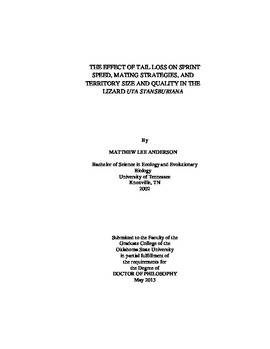| dc.contributor.advisor | Fox, Stanley F. | |
| dc.contributor.author | Anderson, Matthew L. | |
| dc.date.accessioned | 2014-09-24T14:16:26Z | |
| dc.date.available | 2014-09-24T14:16:26Z | |
| dc.date.issued | 2013-05 | |
| dc.identifier.uri | https://hdl.handle.net/11244/10956 | |
| dc.description.abstract | Scope and Method of Study: The study was primarily a field based effort to monitor and document changes in the behavior, mating strategies, and territory size and quality of a population of the lizard Uta stansburiana following tail autotomy. The study had three objectives, to determine if tail loss: 1. reduces sprint performance in one or both sexes of U. stansburiana and if so how one or both sexes might compensate, 2. changes behavior of either sex in the field (focusing on territorial aggression, mating strategies, and foraging rate), and 3. leads to decreases in survivorship, territory size, or territory quality (measured by assessing territorial overlaps, microhabitat diversity, distance moved between sightings, and days between sightings). | |
| dc.description.abstract | Findings and Conclusions: I documented changes in sprint performance, territorial and foraging behavior, territory size and quality, movements, and mating strategies in the lizard Uta stansburiana following tail autotomy. This species is sexually dimorphic and the effects of autotomy are clearly different between the sexes. Males showed a clear compensatory effort to maintain sprint performance following tail loss, whereas females did not. Males responded to intruders into their territories more aggressively than females, but tail loss did not affect aggression in either sex. Males attacked real tethered intruders more aggressively than mirrorimage intruders, regardless of tail status. Focal observations were used to uncover subtle differences in behavior between tailed and tailless individuals. Tailless males behaved less conspicuously than tailed males. Tailless females increased foraging rate, potentially offsetting the burdens of tail regeneration during the energetically demanding reproductive season. However, this increased foraging did not lead to increased fecal production in tailless females. Tail loss negatively impacted survivorship in both sexes. When looking at territory quality, tailless males displayed a pattern consistent with a switch from territoriality to a sneaker strategy, i.e., they moved greater distances, expanded their home range and maintained multiple overlaps with females, while not defending rare microhabitats. Post-autotomy females signaled lowered social status with the lack of their tail, fought less, and made the best of a bad situation. As predicted, tail loss did not alter female territory size or overlaps. Overall, clear sexual differences in the strategies of U. stansburiana following tail autotomy were observed. By addressing a single adaptation, tail autotomy, and examining its costs, this study elucidated the sexually disparate effects of tail autotomy on life-history, territoriality, behavior, and mating strategy in U. stansburiana. | |
| dc.format | application/pdf | |
| dc.language | en_US | |
| dc.rights | Copyright is held by the author who has granted the Oklahoma State University Library the non-exclusive right to share this material in its institutional repository. Contact Digital Library Services at lib-dls@okstate.edu or 405-744-9161 for the permission policy on the use, reproduction or distribution of this material. | |
| dc.title | Effects of tail loss on sprint speed, mating strategies, and territory size and quality in the lizard Uta Stansburiana | |
| dc.contributor.committeeMember | Lovern, Matthew B. | |
| dc.contributor.committeeMember | Grindstaff, Jennifer | |
| dc.contributor.committeeMember | Gregory, Mark | |
| osu.filename | Anderson_okstate_0664D_12626.pdf | |
| osu.accesstype | Open Access | |
| dc.type.genre | Dissertation | |
| dc.type.material | Text | |
| thesis.degree.discipline | Zoology | |
| thesis.degree.grantor | Oklahoma State University | |
